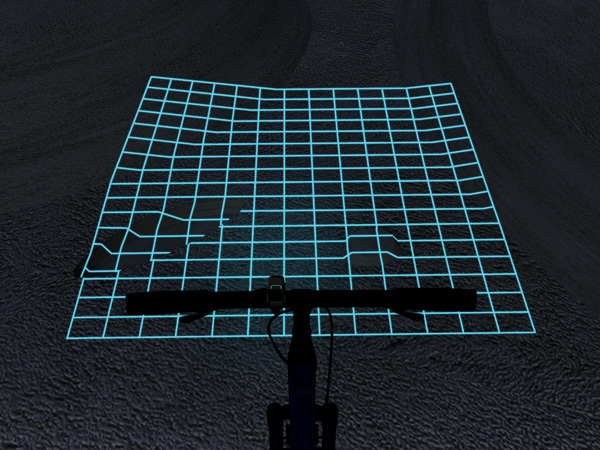First there was the LightLane (a mashup of sort-of-cool, vaguely-useful, and frankly-geeky), then there was the GPS Citibike-station-finding helmet (which was downright odd). Now, the internet has brought you: Lumigrids.
Seriously, the design people from Tron have so much to answer for. An entire generation of early-adopting computer nerds see a grid like that and it's practically Pavlovian. It must be awesome! Look at those glowing blue lines!
Okay, it's hard not to let the sarcasm hounds off the leash. It's just so overbuilt. The idea here is that a light on the front of your bike projects this grid at the ground in front of you. On a flat road (I'm told there is such a thing) it shows up as a regular grid. If there's a concavity or convexity (as in the picture above) the lines break in a way that, trained by decades of early computer graphics, we're supposed to recognize, interpret, and thus avoid the pothole.
 |
| If you're over a certain age, somewhere in your deepest memories an image like this says 'supercomputer' with a side helping of 'Airwolf.' It's sad but true. |
Also, I haven't got data to back this up, but it seems to me like your brain probably wouldn't be able to process the grid and changes in its pattern fast enough to be of much use. Look at the first picture again. Quick, quick, where's the bump and where's the hole? And the edges are slanted: where does the slanting start? How high/deep are any of those features? You have a split second to figure that out and decide whether to avoid or take the bump. And there's a car behind you, the speed of which you can't quite gauge by ear.
By the way, you've distracted that driver with the weird-ass glowing grid on the pavement in front of you, which she has never seen before and will undoubtedly do a double-take over.
And to be fair, you've distracted yourself, because as you zip along the street, staring at the blue grid, trying to read it for information as to the pavement in front of you, you're not attending to much else. You've dedicated rather a lot of cognitive resource to reading and interpreting a four-foot-square pattern.
Not only that, but it looks to me as though the grid lines would be okay at picking out large, fairly regular features (the most encouraging of their demo pictures is the one that shows where a sharp curb is) but I can easily imagine what they'd look like when faced with gravel, a really serious set of potholes, the average uneven and broken-up Ottawa street - I'm thinking of Main Street in particular here - or snow. And that's not even getting into what would happen if it were actually raining or snowing, with your bright blue projection catching every little raindrop or snowflake and making the area immediately in front of you into a disco ball.
Nice try, design folks. But, you see, I could just go get a couple of these for $30. Having used them to ride along the unlit and forested River Path at two in the morning, I can attest they do the job quite adequately.







